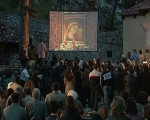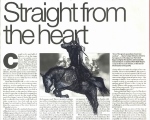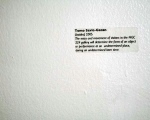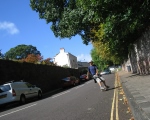In 1467 the Madonna del Buonconsiglio miraculously appeared in the town of Genazzano near Rome, descending from a cloud and hovering before an unfinished church wall and immediately became a site of pilgrimage and devotion. At the same time, Our Lady of Shkodra, the most venerated icon in Albania, was seen, at the height of the Ottoman siege, floating up into the sky, and was followed by two Albanian witnesses all the way to Rome, where they lost sight of it. The holy legend was kept alive from generation to generation and the Madonna was prayed to in Albania’s darkest times of foreign occupation and religious persecution, with hope expressed by the hymn ‘Madonna of Good Counsel, return to us’.
This intertwined legend became the subject of one of the most enchanting contemporary artworks, the film PilgrIMAGE (2005) by Adrian Paci, himself a native of Shkodra and now resident in Italy. The artist filmed the painting of the Madonna, showing it carefully secured in its chapel as if its Italian guardians were afraid that it could take off again, subsequently holding a public screening in Shkodra for her Albanian faithful. Paci recorded this encounter and in the most exquisite manner, projected it back to the Madonna herself in the solitude of the chapel. Precisely in the act of showing the projection to the Madonna, the artist admits the possibility of the miraculous, and by intervening in the centuries-long parallel but shared history of the painting, contributes through his ethical approach to the sum of human happiness.
Arguably this work resists the customary interpretation in terms of binaries such as engaged versus autonomous art, which are a straight forward inheritance from modernist art theory. Equally, the division between the modernist legacy of the solo artist as self-referential and the contemporary affection for the collaborative, socially-engaged, community-based artist, no longer holds. Collaborative projects can turn into vehicles for the enhancement of an individual’s career and ego, while individualist works such as this, have the potential to contribute more to the quality of life for a community. PilgrIMAGE has the quality of sustainable art, in the sense that the work creates a significant artistic effect by intervening in the web of interactions and meanings around an object, without excessive use of materials or unjustified actions, through the efficient use of new technologies.
Hungarian artist Beata Veszely sets out to explore the impossible: ‘Experience is really experience, something that really happens, something to make work about, only when we are pushed to the limit of the possible…The experience of the impossible is the very quality that defines religion and there is a fundamentally religious quality to human experience itself.’ The revival of interest in the mythic and spiritual marks a break with the secularist legacy of modernity and is fundamental to the premise of sustainability for enhancing quality of life. This interest should not be mistaken for the post-modernist tendency towards a quasi-anthropological fascination with the religious patterns of the Other.
Beata Veszely’s means for engaging with the impossible is through the practice of horse archery, an ancient art that offers a way to reconnect with old knowledge neglected by the modern world. Horse archery is a way of life, the artist states, and through her connectedness with the animal, the natural environment, and indirectly with the traditions of the nomadic culture of the Eurasian Steppes, she points her arrow at a forgotten quality of life. The mythical figure of the horse archer also appears as a kind of timeless superhero drawn on press cuttings, as a source of protection and guidance in uncertain times, existing somewhere beyond the fragmentary truths of contemporary life.
The rigid divide between autonomous art, for which the highest imaginable function is to have no function, and instrumental art, which is accused of sacrificing artistic freedom for the sake of a political message, is a direct legacy of modernism, and still informs many widely-held assumptions about the nature of artistic engagement. Recent theoretical reassessments of artistic autonomy however, point to a degree of convergence in contemporary art between approaches formerly considered to be binary opposites. Christoph Menke has argued that along with autonomy, art in modernity achieves sovereignty, which enables it to raise claims against rationality.1 It might therefore be suggested that the autonomy of art guarantees its status as a separate sovereign sphere, with a resultant independence from the rules and conventions of society. It is autonomy that gives art, as well as artists as social actors, the potential to be free and able to offer alternatives to dominant ideological paradigms. So, sustainability of art recognises no contradiction between autonomy and engagement, as long as the formal qualities are fulfilled, as it is precisely the autonomy of art that creates a space for resistance.2
Despite its extremely reduced and concentrated form, the work of Tomo Savić Gecan, Amsterdam based artist of Croatian origin, touches on issues from the critical potential of autonomous art, to the contemporary engagement with conceptual art. His work is both decidedly autonomous, usually consisting of little more than a sentence on a gallery wall, and yet directed outwards to society, encouraging criticality through the succinct philosophical dilemmas it poses. A work for the Croatian Pavilion in Venice 2005 consisted of a text that read: ‘During the 51. Biennale di Venezia movements of the visitors of W139, Center for Contemporary Art in Amsterdam, The Netherlands, change the temperature of the water in the swimming pool of Spordiklubi Reval-Sport in Tallinn, Estonia by 1° C.’ There is an undeniable reference to well-worn conceptual practices, but his work escapes text-based self-referentiality by always pointing to a concrete effect in the real world. With Gecan, we are clearly dealing with an individual artist, yet his concerns are contemporary and unselfish, his work gaining its meaning from the responses and interactions with people, and the overcoming of conventional binary oppositions, such as between gallery based and public art.
A further point to Gecan’s art practice is its compliance with the formal requirements of sustainability. If High Modernism was concerned with the formal properties of the artwork, perhaps surprisingly, sustainability of art is equally so. Ultimately, it is not a question of the content of a work, whether it has a relevant political or ecological message, but rather a matter of formal appearance.3 Sustainability of form implies an awareness of the environmental impact of the created work, responsible use of materials or resources, and a non-exploitative approach. Dematerialisation and recycling are two possible modes for realising sustainable form. While dematerialisation questions art as commodity, and asks whether there are ‘limits to growth’4 of our stockpile of art objects, a key trait of recycling in sustainable art is its application to concepts rather than materials. In short, if for modernism form was a question of aesthetic values, in the sustainability of art, form is a matter of ethical values.
Content-wise, the ideas of sustainability have spread as pressing and universal issues, and are no longer the preserve of self-declared environmental artists. In Stories are Propaganda (2005), Rirkrit Tiravanija and Philippe Parreno deal with the impact of globalisation, in the wake of their joint trip to China, where the film was shot. A picture of a magician pulling a rabbit out of his hat stands as a symbolic condensation of the film, while a young boy’s voice recites an elegy to the slipping away of the past into the unstable category of nowness. They conjure up the ‘good old days’ before ‘cappuccino and sushi and ruccola went global…Before adventure became a sport, and nature became a spot. Before cell phone conversations were banned on trains. Before googling became an aspect of human behaviour… Before we started looking at the world as a standing stock of material.’ Despite what appears to be strong criticism of the unforeseeable effects of globalisation on the environment and quality of life, there remains a note of ambivalence, as suggested by the get-out-clause of the title. If their narrative confesses to being a modern fairy tale, then the precious ambiguity beloved of the consumerist art game is preserved. Social criticism is deflected into non-threatening channels of entertainment and art spectacle.
Returning to the legacy of modernism for contemporary sustainable art, a useful distinction is made between the divergent lines of the classical avant-garde and high modernism.5 High modernism stressed formal evolution of style, and in its Greenbergian version, entailed the progressive purification of the visual field, and the maintenance of strong disciplinary boundaries. The avant-garde strain of modernism is more attractive for contemporary sustainable art, essentially for the utopian element that contains and engenders the desire to radically transform society. The conceptual art of the early 70s, especially in its Eastern-European market-free incarnation, transmitted the avant-garde impulse into the contemporary era, and at the same time, marked an epochal divide from modernism’s interest in high art, stylistic novelty and dichotomous thinking.
The British artist Heath Bunting investigates the wide possibilities open to the creatively-minded twenty-first century urban dweller. His work suggests a radically different model to that of the metropolitan flaneur, a figure so beloved of modernist art and literature. The artist of today does not drift through the city seeking sensory stimulation and fleeting impressions, but sets out on a skateboard in search of the ingredients for a sustainable existence. Food for Free (2005) is one such project, which maps the sources of naturally-occurring food in the bioregion of Bristol. Detailed information about edible plants and organisms, their locations and seasons, is plotted on an online map, which significantly has no street names, as if to insist on the primacy of the natural ecology of the city beyond the overlays of modern culture.6
The autonomy of his practice derives from its ultimate freedom – freedom to climb trees, fences, and other urban structures, to break rules and conventions he considers to be wrong. Bunting also protects his autonomy from outside interference, in particular from the institutionalised structures of the art world, which effect the choices artists make from conception to realisation, through their programmatic funding strategies. His website lists many projects as funded by ‘none, none, none’, and they are characterised by complete independence from the managed settings of gallery and ‘public space’. The net, earlier championed as a virtual space of freedom, exists for Heath Bunting as an extension of public space, subject to the same forces of social control, and therefore he significantly moved from the realm of internet art to real life situations. Perhaps it is not useful to think about canoeing, rehearsing evacuation to a cave, or bridging a river in terms of high art versus low, it is rather the traces of the avant-garde that give an enigmatic and irreducible quality to his work.
Finally, the pleasure-based principle for understanding and evaluating artworks is usually poles apart from the school of socially-engaged art criticism. If the notorious ‘I like’ approach clearly lacks the tools for appreciating contemporary artworks for which aesthetic categories are not of primary significance, the opposite extreme wilfully ignores the aesthetic dimension, so as not to distract from the serious-mindedness of its social engagement. The works discussed here destabilise these categories and require finding an alternative, in order to avoid, as to Martin Seel puts it, being ‘forced to chase the sins of sensuousness from the temple of art theory.’71 Christoph Menke, The Sovereignty of Art: Aesthetic Negativity in Adorno and Derrida (MIT: Cambridge, Mass., 1998), 254.
2 For ‘resistance’ in contemporary art, see Gerald Raunig, Art and Revolution, Art Activism in the Long 20 th Century (EIPCP: Vienna, 2005).
3 See also, Maja and Reuben Fowkes, ‘Principles of Sustainability in Contemporary Art,’ Praesens: Central European Contemporary Art Review no.1 2006, pp.5-11.
4 As in the well-known title of the Club of Rome’s crucial environmental report, Donella H. Meadows et al., The Limits to Growth (New York: Universe Books, 1972).
5 See, Peter Bürger, Theory of the Avant-Garde (University of Minnesota Press: Minnesota, 1985).
6 See also, Maja and Reuben Fowkes, ‘The Art of Making Do with Enough,’ in The New Art (Rachmaninoff’s: London, 2006).
7 Martin Seel, Aesthetics of Appearing(Cultural Memory in the Present) (Stanford University Press: Stanford, 2004), xi.
www.translocal.org





